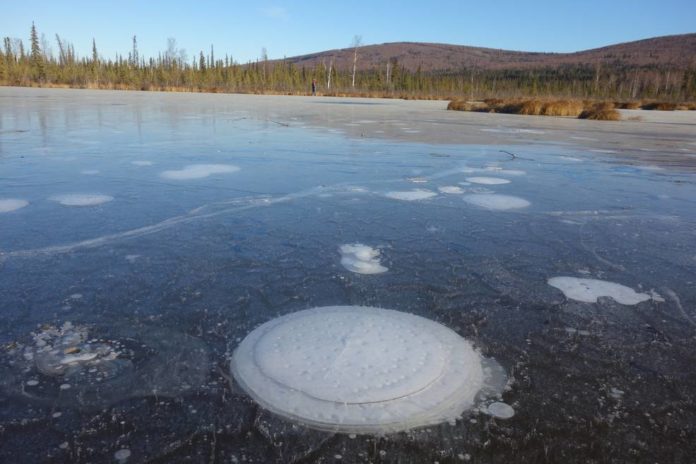New NASA-financed research about has found that Arctic permafrost’s normal slow thawing and the related arrival of greenhouse gases to the environment may really be accelerated by examples of a moderately minimal known process called sudden thawing. Sudden thawing happens under a specific kind of Arctic lake, known as a thermokarst lake that structures as permafrost thaws.
The effect on the atmosphere may mean an inundation of permafrost-determined methane into the air in the mid-21st century, which isn’t currently represented in atmosphere projections.
The Arctic landscape stores one of the biggest normal repositories of organic carbon on the planet in its frozen soils. Be that as it may, once defrosted, soil microorganisms in the permafrost can transform that carbon into the greenhouse gases carbon dioxide and methane, which at that point go into the environment and add to climate warming.
Katey Walter Anthony at the University of Alaska, Fairbanks said, “The mechanism of abrupt thaw and thermokarst lake formation matters a lot for the permafrost-carbon feedback this century. We don’t have to wait 200 or 300 years to get these large releases of permafrost carbon.”
“Within my lifetime, my children’s lifetime, it should be ramping up. It’s already happening but it’s not happening at a really fast rate right now, but within a few decades, it should peak.”
Scientists used a combination of computer models and field measurements and discovered unexpected thawing dramatically increases previous estimates of permafrost-derived greenhouse warming. They found that the sudden abrupt process increases the release of ancient carbon put away in the soil 125 to 190 percent contrasted with slow defrosting alone.
They also discovered future warming scenarios defined by the Intergovernmental Panel on Climate Change, abrupt thawing was as important under the moderate reduction of emissions scenario as it was under the extreme business-as-usual scenario.
It suggests indeed, even in the situation where people diminished their global carbon emissions, vast methane discharges from sudden defrosting are still prone to happen.
Walter Anthony said, “However, in the presence of thermokarst lakes, permafrost thaws deeper and more quickly. Thermokarst lakes form when substantial amounts of ice in the deep soil melt to liquid water. Because the same amount of ice takes up more volume than water, the land surface slumps, and subsidies, creating a small depression that then fills with water from rain, snowmelt, and ground ice melt. The water in the lakes speeds up the thawing of the frozen soil along their shores and expands the lake size and depth at a much faster pace than gradual thawing.”
“Within decades you can get very deep thaw-holes, meters to tens of meters of vertical thaw. So you’re flash thawing the permafrost under these lakes. And we have very easily measured ancient greenhouse gases coming out. These ancient greenhouse gases, produced from microbes chewing through ancient carbon stored in the soil, range from 2,000 to 43,000 years old.”
Scientists caught methane rising out of 72 locations in 11 thermokarst lakes in Alaska and Siberia to gauge the measure of gas discharged from the permafrost beneath the lakes, and in addition, utilized radiocarbon dating on captured samples to decide their age. They contrasted the emanations from lakes with five areas where slow defrosting happens. What’s more, they utilized the field estimations to assess how well their model reproduced the natural field conditions.
Scientists then used U.S. Topographical Survey-NASA Landsat satellite symbolism from 1999 to 2014 to decide the speed of lake extension over a substantial locale of Alaska. From this information, they could evaluate the measure of permafrost changed over to a defrosted soil in lake bottoms.
Co-author Guido Grosse of AWI said, “While lake change has been studied for many regions, the understanding that lake loss and lake gain have a very different outcome for carbon fluxes is new. Over a few decades, thermokarst lake growth releases substantially more carbon than lake loss can lock in permafrost again [when the lake bottoms refreeze].”
“Because the thermokarst lakes are relatively small and scattered throughout the Arctic landscapes, computer models of their behavior are not currently incorporated into global climate models. However, Walter Anthony believes including them in future models is important for understanding the role of permafrost in the global carbon budget.”
“Human fossil fuel emissions are the number one source of greenhouse gases to the atmosphere, and in comparison, methane emissions from thawing permafrost make up only one percent of the global methane budget. But by the middle to end of the century, the permafrost-carbon feedback should be about equivalent to the second strongest anthropogenic source of greenhouse gases, which is land use change.”
The results were published in Nature Communications.
